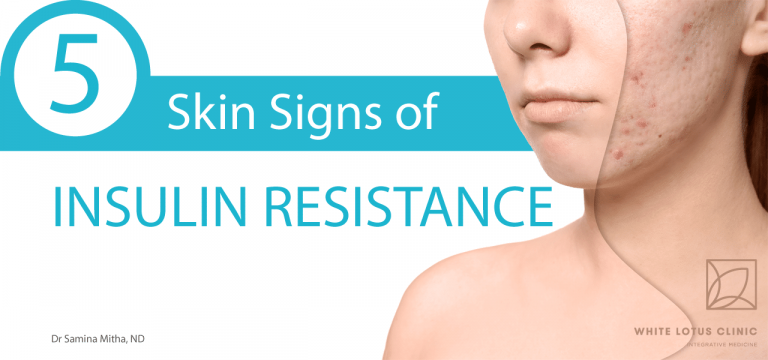5 Skin Signs of Insulin Resistance
Insulin is a major hormone that is produced in the body and can influence the health of your skin. This may sound surprising to you since we don’t necessarily associate insulin with skin health. Today, I’m going to break it down for you and show you how skin signs can be a clue in determining whether you have insulin resistance.

What is insulin resistance?
When you consume something that contains glucose or gets broken down into glucose molecules—such as carbohydrates—your body responds by producing insulin from your pancreas. Insulin is then responsible for transporting glucose into our cells by binding to the cell’s receptor sites. This allows for glucose to enter the cell. Once inside the cell, glucose can be used as energy.
Insulin resistance occurs when the cell has a reduced responsiveness to this hormone. The receptors that bind to insulin become less responsive to it, and now glucose can’t get into the cell. The result is higher insulin and glucose levels in the blood, as well as a host of symptoms that go along with it.

Skin Health and Insulin Resistance
Our skin is often a direct reflection of what is truly happening inside our bodies. As a result, insulin resistance is often apparent in 5 distinct skin signs. Below are the most common skin manifestations of this resistance.
Skin Darkening - (Acanthosis Nigricans)
- This is known as skin darkening, and is hyperpigmentation that’s typically brown to black, poorly defined, and velvety. It’s typically found in skin folds such as the neck, armpits, elbows, groin and navel. [3]
- The endocrine origin of acanthosis nigricans results from the complex connection between insulin and insulin-like growth factor-1 (IGF-1) receptors on keratinocytes (aka skin cells). [4]
Skin Tags - (Acrochordons)
- A skin tag is a small, benign tumor that forms on the skin typically on the neck, torso and groin area. Several studies have found an association of acrochordons to impaired glucose tolerance and diabetes. [3]
A Type of Hair Loss Known as Androgenetic Alopecia
- This type of hair loss is dependent on androgens (testosterone). [3] We can deduce that higher blood insulin levels cause higher testosterone levels, resulting in androgenic alopecia. Additionally, research indicates that the skin of diabetic rats were found to show apparent hair shaft thinning. [2]
The Skin Condition of Hidradenitis Suppurativa
- This is a skin condition that presents as skin abscesses and scarring. It occurs near hair follicles and sweat glands in areas such as the groin, buttocks, breasts and armpits. Research has determined higher prevalence of hidradenitis suppurativa in patients with higher homeostasis model assessment of insulin resistance (HOMA-IR). [5]
Acne
- Acne is known as one of PCOS’s clinical manifestations. The research suggests that patients with PCOS who have acne have higher levels of basal insulin, fasting blood glucose, and HOMA-IR. [1]
These 5 skin signs are what I look for with my patients when assessing for insulin resistance. Remember, your skin can give you clues as to what is happening inside your body. Fortunately, there are many natural options for treating this condition.
Next Steps
References used in this article
- Association between isolated female acne and insulin resistance: a prospective study. – PubMed – NCBI. (n.d.). Retrieved November 8, 2019
- El-Sayyad HIH, Abdraboh ME, Aljebali AMA. Hair Growth Defects of Diabetic and Hypercholesterolemic Wistar Albino Rats and Amelioration of Fish Oil-Treatment Hair Growth Defects of Diabetic and Hypercholesterolemic Wistar Albino Rats and Amelioration of Fish Oil-Treatment. (2015).
- González-Saldivar, G., Rodríguez-Gutiérrez, R., Ocampo-Candiani, J., González-González, J. G., & Gómez-Flores, M. (2017, March 1). Skin Manifestations of Insulin Resistance: From a Biochemical Stance to a Clinical Diagnosis and Management. Dermatology and Therapy, Vol. 7, pp. 37–51.
- Hermanns-Lê, T., Scheen, A., & Piérard, G. E. (2004). Acanthosis nigricans associated with insulin resistance: Pathophysiology and management. American Journal of Clinical Dermatology, Vol. 5, pp. 199–203.
- Vilanova, I., Hernández, J. L., Mata, C., Durán, C., García-Unzueta, M. T., Portilla, V., … González-López, M. A. (2018). Insulin resistance in hidradenitis suppurativa: a case–control study. Journal of the European Academy of Dermatology and Venereology, 32(5), 820–824.




